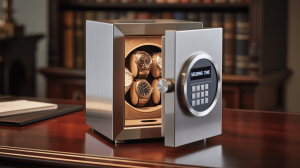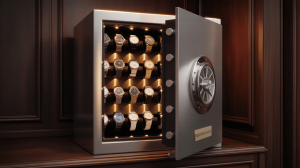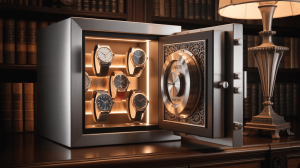Compact & Secure: Best Small Watch Safe Options in 2024. But here’s the kicker… You no longer need a bulky vault to protect your prized timepieces—2024 brings sleeker, smarter, and more secure compact safes built for modern collectors.
1. Why Choose a Small Watch Safe?
Small safes fit into limited spaces—nightstands, desks, closets—while providing essential protection. They deter theft with steel bodies and reliable locks, and guard against scratches with padded interiors. For collectors living in apartments or those short on space, these safes balance stealth and security.
| Feature | Benefit | Notes |
|---|---|---|
| Steel Shell | Resists prying | Durable |
| Lock Type | Keypad, key, or biometric | Customizable access |
| Interior Padding | Foam or velvet | Scratch prevention |
2. Ideal Dimensions for 2024 Models
2024’s top small safes measure roughly 6–10 inches in depth, width, and height. This range fits most watches on pillows plus room for straps. Always measure your intended location—including hinges and clearance—to ensure a perfect fit without wasted space.
3. Locking Technology Trends
Electronic keypads now offer multiple user codes and time‑delay functions. Biometric scanners speed access using fingerprints, and many models combine both for redundancy. Look for AA‑battery operation with low‑battery alerts or USB‑rechargeable packs for uninterrupted use.
4. Interior Organization Innovations
New modular foam inserts feature pre‑cut cavities that you can rearrange on the fly. Integrated track systems let you add or remove watch pillows without redoing the entire layout. 2024 designs include small zip‑pockets for straps, tools, and warranty cards, keeping everything tidy.
| Organizer Type | Function | Advantage |
|---|---|---|
| Modular Inserts | Custom compartment layouts | Flexible storage |
| Track System | Slide‑in watch pillows | Easy reconfiguration |
| Zip‑Pockets | Strap and tool storage | Keeps accessories neat |
5. Fire & Heat Resistance in Compact Form
Several 2024 models boast a 30‑minute UL 72 fire rating at 1,400°F. Advanced insulation—ceramic composites or gypsum panels—keeps the internal temperature under 350°F, safe for watch lubricants and electronic components.
6. Moisture & Dust Protection
IP54‑rated door seals block dust and light splashes. Stainless steel hardware and powder‑coat finishes resist corrosion in humid environments. Many safes now include built‑in desiccant chambers to maintain sub‑50% humidity, preserving leather straps and metal finishes.
7. Discreet Installation Techniques
Under‑bed mounting kits allow safes to tuck beneath frames, while flush‑mount brackets hide them inside closets. Some 2024 safes come with furniture‑integration kits that convert ordinary end tables into concealed watch vaults.
| Installation Method | Visibility | Security Level |
|---|---|---|
| Under‑Bed Kit | Very low | High |
| Flush Mount | Low | Moderate |
| Furniture Kit | Concealed | Very high |
8. Aesthetic Finishes & Customization
Manufacturers now offer matte black, satin white, or wood veneer exteriors. Leather‑wrapped fronts in rich hues blend with décor. Custom engraving options let you add monograms or logos, making your safe both personal and polished.
9. Smart Connectivity Features
Select 2024 models support Bluetooth notifications and app‑based monitoring. Get instant alerts if the safe is moved or tampered with, track battery levels, and view access logs—right from your smartphone.
10. Power & Backup Solutions
Most electronic safes use AA batteries, requiring replacement every 6–12 months. USB‑rechargeable battery packs reduce waste, and integrated solar trickle chargers keep you green. Always keep a manual override key hidden separately for emergencies.
| Power Option | Backup Method | Maintenance |
|---|---|---|
| AA Batteries | Manual key override | Replace biannually |
| USB Pack | Hidden backup key | Recharge monthly |
| Solar Trickle | Factory PIN override | Clean panel quarterly |
11. Security Certifications to Look For
Ensure UL 72 fire ratings and UL RSC or ETL burglary listings. TÜV certified models have passed rigorous European testing standards. Certification ensures the manufacturer’s claims hold up under real‑world conditions.
12. Price Tiers & Value
Entry‑level small safes start around $75, offering basic steel shells and key locks. Mid‑range units ($150–$300) add fire and moisture resistance plus electronic keypads. Premium models ($300+) feature biometrics, smart alerts, and luxury finishes—choose based on must‑have features versus budget.
| Price Tier | Key Features | Ideal Buyer |
|---|---|---|
| $75–$150 | Basic lock, steel shell | New collectors |
| $150–$300 | Fire/moisture resistance, keypad | Enthusiast collectors |
| $300+ | Biometric, connectivity, luxe trim | High‑end collectors |
13. Maintenance Best Practices
Wipe exteriors monthly with a microfiber cloth. Test lock functions quarterly, including backup methods. Replace batteries before low‑battery warnings deactivate the safe. Inspect interior lining annually and replace foam inserts if compressed.
14. Emergency Access Protocols
Store backup keys in a separate secure location—safe deposit box or trusted friend’s home. Memorize or securely record override codes. Register with manufacturer for potential master‑code recovery services in case of lockout.
| Emergency Method | Reliability | Response Time |
|---|---|---|
| Backup Key | Very high | Immediate |
| Override Code | High | Instant |
| Manufacturer Help | Variable | Up to 48 hours |
15. Conclusion: Effortless Security in 2024
Compact safes in 2024 blend cutting‑edge security with refined style and smart functionality. Ready for the good part? Select the model that aligns with your space, aesthetic, and tech preferences to protect your watches effortlessly.
FAQ
Q1: What depth is best for small watch safes?
6–8 inches depth fits most watch sizes on pillows comfortably.
Q2: Are biometric locks reliable in compact safes?
Yes—premium sensors with backup keys safeguard against false rejections.
Q3: Do these safes require professional installation?
DIY anchoring is possible; ensure strong fasteners into studs or concrete.
Q4: How often replace desiccant chambers?
Replace every 6–12 months, depending on local humidity.
Q5: Can I integrate a safe into existing furniture?
Yes—look for models with furniture‑integration kits or flush‑mount options.







